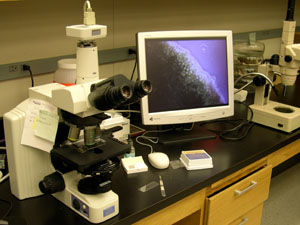Description

No indication of root rot pathogens was observed.
(photo courtesy of Marci Spaw)
Maria mails plant samples along with a Plant Diagnostic Checksheet to a university Plant Pathology Diagnostic Lab. Maria sent two plants exhibiting symptomology and one plant that appeared healthy. Diagnostician Judy O’Mara talks through the steps she goes through to sort out the cause of the chlorosis. Her activities include checking color and health of the plants’ root systems and making a microscope slide from a root section to check for signs of root rot pathogens, requesting pH and electrical conductivity (EC) tests on the root medium, and in-house tests for the common tospoviruses and cucumber mosaic virus. She also consulted several available references and the web to glean leads.
Results
Extension Associate Joy Pierzynski performed saturated medium extracts to measure pH and EC on a sample of root media from each of the plants.
| Sample | Exhibiting Symptoms | pH | EC (mmhos/cm) |
| #1 | Yes | 6.64 | 0.841 |
| #2 | Yes | 6.30 | 0.713 |
| #3 | No | 6.01 | 0.816 |

Test kits from Agdia, a commercial supplier, are used to test for Cucumber MosaicVirus and the tospoviruses INSV (Impatiens Necrotic Spot Virus) and TSWV (Tomato Spotted Wilt Virus).
(photo Courtesy of Marci Spaw)
Extension Associate Joy Pierzynski used Agdia ImmunoStrip Test Kits to perform simple tests for three very common viruses.
| Test | Result |
| Impatiens Necrotic Spot Virus (INSV) | Negative |
| Tomato Spotted Wilt Virus(TSWV) | Negative |
| Cucumber Mosaic Virus | Negative |




